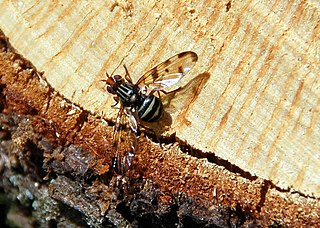
The Ulidiidae or picture-winged flies are a large and diverse cosmopolitan family of flies (Diptera), and as in related families, most species are herbivorous or detritivorous. They are often known as picture-winged flies, along with members of other families in the superfamily Tephritoidea that have patterns of bands or spots on the wings. Some species share with the Tephritidae an unusual elongated posteroapical projection of the anal cell in the wing, but can be differentiated by the smoothly curving subcostal vein. Two species, Tetanops myopaeformis and Euxesta stigmatias, are agricultural pests.

Rhagionidae or snipe flies are a small family of flies. They get their name from the similarity of their often prominent proboscis that looks like the beak of a snipe.

Tachydromia is a genus of hybotid flies. It is widespread around the world, with species found essentially everywhere except the polar regions and some remote islands. They are not very diverse in East and Southeast Asia, or in Africa

Rhagio is a worldwide genus of predatory snipe flies. Several species in this genus are referred to as downlooker or down-looker flies because they sometimes perch on tree trunks in a head-down position. There are approximately 170 species. They can be distinguished from other rhagionids by the open anal cell on the wings and the lack of a kidney-shaped arista.
Estheria is a genus of flies in the family Tachinidae.
Weberia is a genus of flies in the family Tachinidae.

Urophora is a genus of tephritid or fruit flies in the family Tephritidae.
Cephalia flavoscutellata is a species of ulidiid or picture-winged fly in the genus Cephalia of the family Ulidiidae.
Cephalia rufipes is a species of ulidiid or picture-winged fly in the genus Cephalia of the family Ulidiidae.

Empis is a genus of dance fly found in the fly family Empididae.
Omphalophora is a genus of snipe flies of the family Rhagionidae. They are delicate to fairly robust flies, from 3 to 10 mm. they are entirely black or brown in colour.

Gonia is a genus of flies in the family Tachinidae.

Otitinae is the name of a subfamily of flies in the family Ulidiidae. It was formerly the Otitidae. Like the Ulidiinae, most species are herbivorous or saprophagous. Most species share with the Tephritidae an unusual elongated projection of the anal cell in the wing, but can be differentiated by the smoothly curving subcostal vein. Most are dull gray to shiny brown or black flies with vein R1 setulose or, in a few cases, bare.

Chymomyza fuscimana is a species of fly in the family Drosophilidae. It is found in the Palearctic.
Oxyna nebulosa is a species of fruit fly in the family Tephritidae.
Xanthomyia alpestris is a species of tephritid or fruit flies in the genus Xanthomyia of the family Tephritidae.
Discomyzinae is a subfamily of shore flies in the family Ephydridae.

Cephaliini is a tribe of picture-winged flies in the family Ulidiidae.









